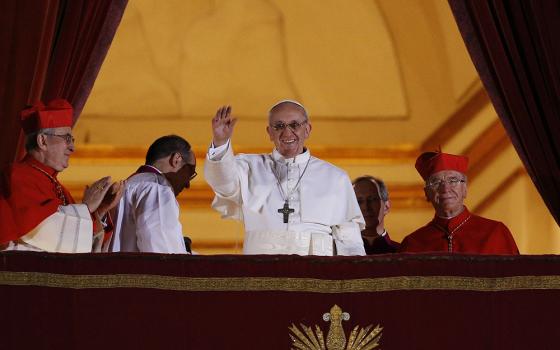Editor's note: This is the first of a two-part blog series. Click here to read part two.
Recently, the ecumenical monastic community of Taizé celebrated three anniversaries. It marked 100 years since the birth of its founder, Br. Roger Schütz; the 10th anniversary of his death; and the 75th anniversary of his first arrival on the idyllic little hill in Burgundy that he would later make famous.
I spent two weeks there this month alongside thousands of other pilgrims, and I would like to share two blog posts with readers of NCR: this one on the community's history, and another on its current activities.
The son of a Swiss reformed pastor, Roger Schütz was born in Provence, Switzerland, on May 12, 1915. Falling ill at a young age, he took to long walks in the countryside, where he developed a contemplative outlook and made a number of personal resolutions having to do with the necessity of self-surrender, forgiveness and hope. Soon after the outbreak of World War II, he set out for France in search for a place where he and a few other like-minded Christians might someday pray. Drawn to the remote region around the town of Cluny, France — the seat of medieval monasticism — he remained in the nearby hamlet of Taizé when two of its villagers pleaded with him to stay: They were so alone out there, they explained, and would love the company.
Together with his sister, Roger sheltered Jews fleeing the Nazi regime and eventually set up a small orphanage as well. These were the first signs that his fledgling vocation would be one of what the French call accueil: "welcoming."
It was also a vocation of reconciliation. After the war, he began to extend hospitality to former German soldiers, too. They were men who had been drafted into a war they did not want to fight, and Roger was one of the only people to show them any compassion or hospitality.
As more of Roger's friends began to join his nascent community, their prayer focused less on reconciliation between nations and more on reconciliation between Christian churches. Roger struggled a great deal with the nature of his Christian identity, longing to reconcile his Protestant origins with a Catholic tradition he grew increasingly to love. His insight was to embrace both traditions without feeling as though he had to choose definitively between them or "break fellowship" with anyone — and to preside over a community whose very charism was the longing for reconciliation.
Today, it is a thriving ecumenical monastic community with over one hundred monks, both Catholic and Protestant, located in Taizé and in a few small communities around the world where the brothers share the lives of the poor. I asked one of them whether there are tensions among brothers in the community who come from different denominations. He replied that there is not, perhaps because their intellectual formation focuses on the study of our shared history.
Pope Francis recently remarked on the Taizé community's significance for the ecumenical movement: It is not that the brothers "are not aware of the differences which still separate us," the pope said, but that "they are able to see beyond them."
The expansiveness of their ecclesial vision has attracted large numbers of pilgrims to the little hilltop village, particularly since the 60s. Many are in their teens or 20s. Visitors to Taizé, myself included, always report being struck by the incongruous sight of thousands of young people rushing to church three times a day when the community's great bells begin to ring.
What do young people find so attractive here?
Brother Roger had a distinctively slow and fragmented speech pattern as a young man, and he later admitted it was difficult for him to find people patient enough to hear him out. For this reason, he wanted his brothers to be available to l'écoute: a ministry of listening. Their vocation is not to judge their visitors' theological ideas or to solve the many personal problems that burden them, but simply to listen to them with the "kind-heartedness" that Brother Roger emphasized over and over again in his speeches and writings.
Indeed, at the formal end of each day's evening prayer, while the choir continues to sing and many worshipers remain to pray, cross-legged, on the floor of the large, earth-toned church, brothers also stay behind to listen carefully to the questions, hopes, fears, sadnesses, and other experiences that individual pilgrims may wish to confide to them.
Of course, the other, better known feature of life at Taizé is its famous repertoire of meditative, repetitive chants. This style of music developed in Taizé in the 1960s as part of its search for a simpler, more universal liturgy that people coming for just a brief period, and from an astonishing array of backgrounds, could learn quickly and participate in together.
The luminosity of these simple chants, which generally are not punctuated by lengthy readings or sermons, creates what one of the brothers in the community, Brother Emile, has called a "non-threatening transcendence." Nor do the prayers have any presider; like the simple faith-sharing groups and community meals that fill the rest of a pilgrim's days in Taizé, they are profoundly non-hierarchical, marked by what the philosopher Paul Ricoeur — a frequent visitor to Taizé, himself, and one who is said to have found solace there during times of personal tragedy — called "the total absence of relationships of domination."
"Goodness is deeper than the deepest evil," Ricoeur once reflected in a conversation with the community of brothers. "We have to liberate that certainty, give it a language. And the language given here in Taizé is not the language of philosophy, or even of theology, but the language of the liturgy."
Like innumerable visitors as well, I can attest that Taizé is one of those holy places in the world where goodness finds a compelling language: a vocabulary of prayer and a grammar of shared Christian life, what Brother Roger often called "a parable of communion."
[Nicholas Collura received his Master of Divinity from the Boston College School of Theology and Ministry in 2014.]



